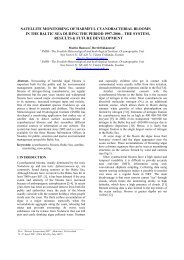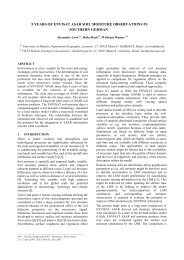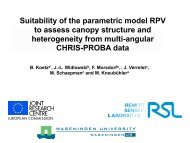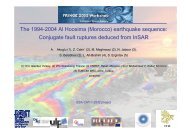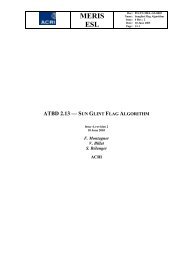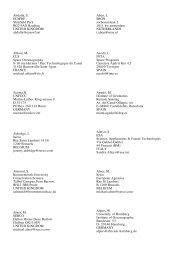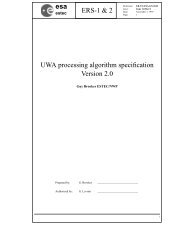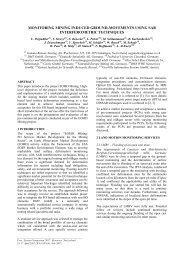MERIS ATBD 2.13 Sun Glint Flag Algorithm
MERIS ATBD 2.13 Sun Glint Flag Algorithm
MERIS ATBD 2.13 Sun Glint Flag Algorithm
Create successful ePaper yourself
Turn your PDF publications into a flip-book with our unique Google optimized e-Paper software.
<strong>MERIS</strong><br />
<strong>MERIS</strong> <strong>ATBD</strong> <strong>2.13</strong><br />
<strong>Sun</strong> <strong>Glint</strong> <strong>Flag</strong> <strong>Algorithm</strong><br />
Ref.: PO-TN-MEL-GS-0005<br />
Issue: 4.3<br />
Date: 18/07/2011<br />
Page: i<br />
Ref.: PO-TN-MEL-GS-0005<br />
Issue: 4.3<br />
Date: 18/07/2011
<strong>MERIS</strong> <strong>ATBD</strong> <strong>2.13</strong><br />
<strong>Sun</strong> <strong>Glint</strong> <strong>Flag</strong> <strong>Algorithm</strong><br />
Preparation and signature list<br />
Ref.: PO-TN-MEL-GS-0005<br />
Issue: 4.3<br />
Date: 18/07/2011<br />
Page: ii<br />
Name and role Company Signature<br />
Prepared by L. Bourg ACRI-ST<br />
Company To<br />
F. Montagner ACRI-ST<br />
V. Billat ACRI-ST<br />
S. Bélanger ACRI-ST<br />
Public distribution<br />
Version Date Changes<br />
Distribution List<br />
Change log<br />
4.3 18/07/2011 Changes following the 3 rd <strong>MERIS</strong> data reprocessing:<br />
Modification of Eq. 14 (typo)<br />
Parameters values updated by Ebushi et Kizu in 2002<br />
References<br />
4.2 10/06/2003<br />
4.1 18/02/2000
<strong>MERIS</strong> <strong>ATBD</strong> <strong>2.13</strong><br />
<strong>Sun</strong> <strong>Glint</strong> <strong>Flag</strong> <strong>Algorithm</strong><br />
Table of Content<br />
Ref.: PO-TN-MEL-GS-0005<br />
Issue: 4.3<br />
Date: 18/07/2011<br />
Page: iii<br />
1 INTRODUCTION -------------------------------------------------------------------------------------------- 5<br />
2 ALGORITHM OVERVIEW --------------------------------------------------------------------------------- 5<br />
3 ALGORITHM DESCRIPTION ------------------------------------------------------------------------------ 5<br />
3.1 THEORETICAL DESCRIPTION ------------------------------------------------------------------------- 5<br />
3.1.1 Physics of the problem -------------------------------------------------------------------------- 5<br />
3.1.2 Mathematical description of the algorithm --------------------------------------------------- 8<br />
3.1.3 Parameter description ------------------------------------------------------------------------- 11<br />
3.1.4 Error budget estimates ------------------------------------------------------------------------ 11<br />
3.2 PRACTICAL CONSIDERATIONS ---------------------------------------------------------------------- 12<br />
3.2.1 Calibration and Validation--------------------------------------------------------------------- 12<br />
3.2.2 Quality control and diagnostics--------------------------------------------------------------- 12<br />
3.2.3 Exception handling ----------------------------------------------------------------------------- 12<br />
3.2.4 Output Product --------------------------------------------------------------------------------- 12<br />
4 ASSUMPTIONS AND LIMITATIONS ------------------------------------------------------------------ 13<br />
4.1 ASSUMPTIONS ------------------------------------------------------------------------------------- 13<br />
4.2 LIMITATIONS -------------------------------------------------------------------------------------- 13<br />
5 REFERENCES ----------------------------------------------------------------------------------------------- 14
<strong>MERIS</strong> <strong>ATBD</strong> <strong>2.13</strong><br />
<strong>Sun</strong> <strong>Glint</strong> <strong>Flag</strong> <strong>Algorithm</strong><br />
List of Figures<br />
Ref.: PO-TN-MEL-GS-0005<br />
Issue: 4.3<br />
Date: 18/07/2011<br />
Page: iv<br />
Figure 1: <strong>Sun</strong> glint geometry ..................................................................................................... 8<br />
Figure 2: Local reference frame ................................................................................................. 9<br />
Figure 3: <strong>Algorithm</strong> flow chart ..................................................................................................10<br />
List of Tables<br />
Table 1: Parameter description .................................................................................................11
1 Introduction<br />
<strong>MERIS</strong> <strong>ATBD</strong> <strong>2.13</strong><br />
<strong>Sun</strong> <strong>Glint</strong> <strong>Flag</strong> <strong>Algorithm</strong><br />
Ref.: PO-TN-MEL-GS-0005<br />
Issue: 4.3<br />
Date: 18/07/2011<br />
Page: 5<br />
This document corresponds to the <strong>MERIS</strong> <strong>ATBD</strong> <strong>2.13</strong>: It describes the algorithm used to<br />
perform a correction for ocean pixels which are contaminated by <strong>Sun</strong> glint (specular<br />
reflection of <strong>Sun</strong> light over ocean waves).<br />
Corrected reflectances are inputs to the atmospheric corrections algorithm (<strong>ATBD</strong> 2.7), and<br />
are made available in the <strong>MERIS</strong> Level 2 Product.<br />
2 <strong>Algorithm</strong> overview<br />
The glint reflectance estimate algorithm is performed on every ocean pixels in the <strong>MERIS</strong><br />
data.<br />
It uses external knowledge of the wind speed and direction, and the illumination and<br />
observation geometry of each pixel, to estimate the level of <strong>Sun</strong> glint contribution to the<br />
surface reflectance.<br />
When that contribution is below a "low threshold" value, it is neglected;<br />
When above that threshold and below a "high threshold", it is substracted from the<br />
signal and a “medium glint” flag is raised;<br />
When above the "high threshold", pixels are flagged as “high glint” and processed,<br />
even if the correction is less reliable. In case the correction yields negative values, it is<br />
disabled.<br />
3 <strong>Algorithm</strong> description<br />
3.1 Theoretical description<br />
3.1.1 Physics of the problem<br />
The estimate of the <strong>Sun</strong> glint contribution to the ocean signal is based on the Cox and Munk<br />
model. These authors have proposed a model that considers the sea surface as a collection<br />
of facets, each with individual slope components zx and zy. The probability distribution of<br />
facet slopes p(zx, zy) depends on the wind speed and direction.<br />
In a target-fixed, local coordinates system with the y axis aligned with the <strong>Sun</strong> azimuth, given<br />
the <strong>Sun</strong> zenith angle sand the sensor zenith angle v and azimuth angle v specifying the<br />
reflected ray, a wave facet specified by the zenith angle and azimuth angle (taken<br />
clockwise from the <strong>Sun</strong>) of its outward normal (Figure 1), the condition for that facet to<br />
reflect <strong>Sun</strong> light in the direction (vv) towards the sensor is:
<strong>MERIS</strong> <strong>ATBD</strong> <strong>2.13</strong><br />
<strong>Sun</strong> <strong>Glint</strong> <strong>Flag</strong> <strong>Algorithm</strong><br />
Ref.: PO-TN-MEL-GS-0005<br />
Issue: 4.3<br />
Date: 18/07/2011<br />
Page: 6<br />
c o s 2 c o s( v ) c o s( s) sin ( v ) sin ( s ) c o s( )<br />
(Eq. 1)<br />
where is the specular reflection angle and is defined as s - v.<br />
According to the law of reflection, the vector difference between the reflected and incident<br />
rays must lie along the facet normal. From this, it is possible to express the facet angles<br />
and as a function of the incident and reflected directions.<br />
The angle formed by the facet normal and the z-axis is computed as:<br />
c o s <br />
c o s c o s <br />
v s<br />
1<br />
( 2 2 c o s 2 )<br />
2<br />
The azimuth of the facet measured clockwise from the sun (y-axis) is:<br />
c o s <br />
s in s in <br />
2 2 2 <br />
s in c o s <br />
(s in v c o s s in s )<br />
s in <br />
v<br />
s in ( 2 2 c o s 2 )<br />
1<br />
2<br />
1<br />
2<br />
(Eq. 2)<br />
(Eq. 3)<br />
(Eq. 4)<br />
The slopes of the wave facet in the x and y-directions zx, zy can be expressed as a function of<br />
the facet azimuth and zenith as follows:<br />
which leads to :<br />
z x s in ta n <br />
(Eq. 5)<br />
z y co s tan <br />
(Eq. 6)<br />
z<br />
z<br />
x<br />
y<br />
sin sin <br />
v<br />
<br />
c o s c o s <br />
s v<br />
s in c o s s in <br />
v s<br />
<br />
c o s c o s <br />
s v<br />
Let W be the wind speed modulus. It is expressed as:<br />
(Eq. 7)<br />
(Eq. 8)<br />
W(j,f) = (W_u(j,f)²+W_v(j,f)²) 1/2 (Eq. 9)<br />
Let be the wind direction in the local frame ( taken clockwise from the sun). If the sun<br />
system (x,y) is rotated through an angle to a new system (x',y') related to the wind
<strong>MERIS</strong> <strong>ATBD</strong> <strong>2.13</strong><br />
<strong>Sun</strong> <strong>Glint</strong> <strong>Flag</strong> <strong>Algorithm</strong><br />
Ref.: PO-TN-MEL-GS-0005<br />
Issue: 4.3<br />
Date: 18/07/2011<br />
Page: 7<br />
direction, then the Cox and Munk model provides facet slopes z'x and z'y in this wind system<br />
as:<br />
where ' = - <br />
Therefore:<br />
<br />
z ' x s in ' ta n <br />
(Eq. 10)<br />
z' y co s ' tan <br />
(Eq. 11)<br />
zx' = cos() zx + sin() zy<br />
zy' = - sin() zx + cos() zy<br />
<br />
<br />
1<br />
c<br />
z ' x<br />
<br />
<br />
<br />
1<br />
u<br />
z 'y<br />
(Eq. 12)<br />
(Eq. 13)<br />
and with<br />
and<br />
, the probability that the facet reflects specularly the<br />
incident radiation in the sensor direction is:<br />
2<br />
1<br />
( 1 / 2 ) C ( 1)<br />
( 1 / 6 ) C ( 3<br />
) <br />
<br />
2 2<br />
21<br />
03<br />
<br />
1<br />
<br />
<br />
2<br />
4<br />
2<br />
2<br />
2<br />
p ( z ' , z ' ) <br />
e . ( 1 / 24 ) C ( 6<br />
3 ) ( 1 / 4 ) C ( 1)(<br />
1)<br />
<br />
40<br />
22<br />
(Eq. 14)<br />
x y<br />
2<br />
u c <br />
4<br />
2<br />
<br />
( 1 / 24 ) C ( 6<br />
3 )<br />
<br />
04<br />
<br />
where:<br />
c(j,f) = (c 0 + c 1 W)1/2 with c 0 = 0,003 and c 1 = 1,92.10- 3 (Eq. 15)<br />
u(j,f) = (u 0 + u 1 W)1/2 with u 0 = 0,000 and u 1 = 3,16.10- 3 (Eq. 16)<br />
C21 = C21 0 + C21 1 W with C21 0 = 0,01 and C21 1 = - 0,0086 (Eq. 17)<br />
C22 = 0,12 (Eq. 18)<br />
C03 = C03 0 + C03 1 W with C03 0 = 0,04 and C03 1 = - 0,033 (Eq. 19)<br />
C40 = 0,40 (Eq. 20)<br />
C04 = 0,23 (Eq. 21)<br />
The <strong>Sun</strong> glint reflectance is then:<br />
r ( )<br />
g ( v , s , ) p ( z x , z y<br />
)<br />
4<br />
4 c o s c o s c o s <br />
s v<br />
3<br />
(Eq. 22)
<strong>MERIS</strong> <strong>ATBD</strong> <strong>2.13</strong><br />
<strong>Sun</strong> <strong>Glint</strong> <strong>Flag</strong> <strong>Algorithm</strong><br />
Ref.: PO-TN-MEL-GS-0005<br />
Issue: 4.3<br />
Date: 18/07/2011<br />
Page: 8<br />
where the Fresnel reflection coefficient r() can be considered as a constant (0,02) for<br />
incidence between 0 and 50 degrees.<br />
Values of parameters listed above are those of the original Cox & Munk publication (1954).<br />
Ebuchi and Kizu (2002) have proposed a reviewed parameterisation of the probability<br />
distribution function from Geostationary Meteorological Satellite (GMS) and vectors winds<br />
observed by scatterometers. We recommend using their linear regressions for c and u:<br />
c 0 = 0,0048 and c 1 = 1.52.10 -3<br />
u 0 = 0,0053 and u 1 = 6.71.10 -4<br />
- <br />
s<br />
- <br />
Figure 1: <strong>Sun</strong> glint geometry<br />
3.1.2 Mathematical description of the algorithm<br />
v<br />
<br />
The <strong>Sun</strong> glint reflectance observed by <strong>MERIS</strong> is estimated at each ocean pixel taking as<br />
inputs:<br />
The <strong>Sun</strong> zenith and azimuth angles, observer zenith and azimuth angles at the pixel,<br />
interpolated from the level 1 product annotation at the nearest tie points;<br />
The wind at 10m vector in the local frame, taken at the nearest tie point.<br />
The local reference frame FL is defined at the pixel, with the x axis pointing Eastward, the<br />
y-axis pointing Northward and the z-axis aligned with the outward local normal (Figure 2).
<strong>MERIS</strong> <strong>ATBD</strong> <strong>2.13</strong><br />
<strong>Sun</strong> <strong>Glint</strong> <strong>Flag</strong> <strong>Algorithm</strong><br />
Figure 2: Local reference frame<br />
Ref.: PO-TN-MEL-GS-0005<br />
Issue: 4.3<br />
Date: 18/07/2011<br />
Page: 9<br />
The <strong>Sun</strong> glint reflectance is estimated following the development in § 3.1.1 above. It is then<br />
converted to TOA reflectance *g using an estimate of atmospheric transmittance:<br />
t = exp(-(R(b,j,f) + oz(b,j,f))/cos(s(j,f))) exp(-(R(b,j,f) + oz(b,j,f))/cos(v(j,f)))<br />
*g = t g<br />
If *g in [GLINT_THR_LOW... GLINT_THR_HIGH]<br />
Then 'T = T - *g + GLINT_THR_LOW and Me<strong>Glint</strong> = TRUE<br />
if *g> GLINT_THR_HIGH<br />
then High<strong>Glint</strong> = FALSE.<br />
Values for GLINT_THR_LOW and GLINT_THR_HIGH are determined following tests of the<br />
Atmospheric Correction above water (see <strong>ATBD</strong> 2.7) in presence of increasing amount of<br />
glint. GLINT_THR_LOW is fixed at the lowest level where glint influences the results of the<br />
atmosphere correction. GLINT_THR_HIGH depends on the value of the TOA reflectance at<br />
865 nm (the band most sensitive to glint in the atmospheric correction): glint correction is
<strong>MERIS</strong> <strong>ATBD</strong> <strong>2.13</strong><br />
<strong>Sun</strong> <strong>Glint</strong> <strong>Flag</strong> <strong>Algorithm</strong><br />
Ref.: PO-TN-MEL-GS-0005<br />
Issue: 4.3<br />
Date: 18/07/2011<br />
Page: 10<br />
disabled when *g exceeds a specified fraction (0.8) of the observed reflectance. In such<br />
case, all level 2 products except water vapour should be flagged.<br />
W in d u a n d v<br />
c o m p o n e n ts<br />
C a rte sia n -><br />
p o la r<br />
W in d sp e e d<br />
m o d u lu s<br />
F irst-o rd e r<br />
p o ly n o m ia ls<br />
c, u ,c ij<br />
c o e ff.<br />
d o n o t c o rre c t<br />
d o n o t fla g<br />
fla g " U n c g lin t"<br />
d o n o t c o rre c t<br />
w<br />
G L IN T _ T H R _<br />
L O W<br />
No<br />
D iffe re n c e<br />
No<br />
s<br />
*g ><br />
<br />
G L IN T _ T H R _ L O W<br />
* g ><br />
G L IN T _ T H R _ H IG H<br />
C o rre c t a n d fla g<br />
fla g to w a rd s a tm o sp h e re<br />
Y e s<br />
Y e s<br />
s v <br />
Figure 3: <strong>Algorithm</strong> flow chart<br />
s v v<br />
R e fle c tio n<br />
c o n d itio n<br />
<br />
P ro b a b ility<br />
d e n sity e stim a te<br />
p (z 'x ,z 'y )<br />
R e fle c ta n c e<br />
e stim a te<br />
g<br />
fla g " M e G lin t"
3.1.3 Parameter description<br />
<strong>MERIS</strong> <strong>ATBD</strong> <strong>2.13</strong><br />
<strong>Sun</strong> <strong>Glint</strong> <strong>Flag</strong> <strong>Algorithm</strong><br />
Ref.: PO-TN-MEL-GS-0005<br />
Issue: 4.3<br />
Date: 18/07/2011<br />
Page: 11<br />
Table 1: Parameter description (i=input ; c=intermediate computed parameter ;o=ouput)<br />
Symbol Descriptive name I/O Origin<br />
s[j,f] <strong>Sun</strong> zenith angle for pixel j,f i interpolated from Level 1b<br />
product tie points<br />
s[j,f] <strong>Sun</strong> azimuth for pixel j,f i interpolated from Level 1b<br />
product tie points<br />
v[j,f] Observer zenith angle for pixel j,f i interpolated from Level 1b<br />
product tie points<br />
v[j,f] Sensor azimuth for pixel j,f i interpolated from Level 1b<br />
product tie points<br />
W_u, W_v Wind vector components i interpolated from Level 1b<br />
product tie points<br />
0 1<br />
c , c<br />
Polynomial coefficients for c i<br />
0<br />
c = 0.0048<br />
1<br />
c = 0.00152<br />
0 1<br />
u , u<br />
Polynomial coefficients for u i<br />
0<br />
u = 0.0053<br />
1<br />
u = 0.000671<br />
0 1<br />
C21 , C21<br />
Polynomial coefficients for C21 i<br />
0<br />
C21 = 0.01<br />
1<br />
C21 = - 0.0086<br />
0 1<br />
C03 , C03<br />
Polynomial coefficients for C03 i<br />
0<br />
C03 = 0.04<br />
1<br />
C03 = - 0.033<br />
C40, C22, C04 Weighting factors in p(z'x,z'y) i C40=0.4<br />
C22= 0.12<br />
C04= 0.23<br />
r() Fresnel reflection factor i 0.022<br />
GLINT_THR_LOW Threshold for low glint i 5.0 10 -4<br />
GLINT_THR_HIGH Threshold for high glint i 0.2<br />
g Reflectance estimate at surface c<br />
g Reflectance estimate at TOA c<br />
T Atmospheric transmittance c<br />
MEGLINT_F(j,f) <strong>Flag</strong> for medium glint o<br />
HIGHGLINT_F(j,f) <strong>Flag</strong> for uncorrected glint o<br />
3.1.4 Error budget estimates<br />
Because of<br />
The uncertainty on wind from ECMWF global models (typically 2 m.s -1 on wind speed);
<strong>MERIS</strong> <strong>ATBD</strong> <strong>2.13</strong><br />
<strong>Sun</strong> <strong>Glint</strong> <strong>Flag</strong> <strong>Algorithm</strong><br />
The error bars of the Cox and Munk model,<br />
Ref.: PO-TN-MEL-GS-0005<br />
Issue: 4.3<br />
Date: 18/07/2011<br />
Page: 12<br />
there is an uncertainty in the determination of g. The value of GLINT_THR_LOW should be<br />
established taking that uncertainty into account so as to avoid "over correcting".<br />
The value of GLINT_THR_HIGH will be established taking the saturation of the aerosol<br />
correction dedicated channels (705, 775, 865 nm) into account: It is not worth correcting<br />
these pixels for glint.<br />
3.2 Practical considerations<br />
3.2.1 Calibration and Validation<br />
The value of GLINT_THR should be established using:<br />
1. Simulation results, establishing the <strong>Sun</strong> glint sensitivity threshold of the atmosphere<br />
correction algorithm;<br />
2. Airborne images of reflectance (a high spectral resolution is not necessary).<br />
The glint reflectance estimate may be implemented in Look-Up Tables.<br />
3.2.2 Quality control and diagnostics<br />
The PCD in the Level 1 product header, indicating the quality of the available wind data,<br />
should be repeated in the Level 2 product header to notify the likely error in the size of the<br />
<strong>Sun</strong> glint patch.<br />
3.2.3 Exception handling<br />
N/A<br />
3.2.4 Output Product<br />
The output of the algorithm is a boolean flag for each pixel of the frame: <strong>Glint</strong>_f[j,f]. When<br />
true, that flag indicate that the pixel is (most likely) meaningfully affected by <strong>Sun</strong> glint and<br />
should not be processed further. Another flag indicates when the correction has been<br />
applied.
<strong>MERIS</strong> <strong>ATBD</strong> <strong>2.13</strong><br />
<strong>Sun</strong> <strong>Glint</strong> <strong>Flag</strong> <strong>Algorithm</strong><br />
4 Assumptions and Limitations<br />
4.1 Assumptions<br />
No further assumptions than mentioned in 3.1 above.<br />
4.2 Limitations<br />
Ref.: PO-TN-MEL-GS-0005<br />
Issue: 4.3<br />
Date: 18/07/2011<br />
Page: 13<br />
This algorithm accepts as an established reference the Cox and Munk model. That model<br />
does not provide a complete description of the wave slope distribution:<br />
1. Swell, not related to local wind, is not taken into account;<br />
2. The model is valid for a deep ocean where interaction with the sea bottom is negligible.<br />
In reality, the wave profile is distorted when the sea bottom gets close to the surface.
5 References<br />
<strong>MERIS</strong> <strong>ATBD</strong> <strong>2.13</strong><br />
<strong>Sun</strong> <strong>Glint</strong> <strong>Flag</strong> <strong>Algorithm</strong><br />
Ref.: PO-TN-MEL-GS-0005<br />
Issue: 4.3<br />
Date: 18/07/2011<br />
Page: 14<br />
[1] Cox, C.; Munk, W. Statistics of the Sea Surface Derived from <strong>Sun</strong> Glitter. J. Mar. Res.<br />
1954, 13, 198-227.<br />
[2] Cox, C.; Munk, W. Measurement of the Roughness of the Sea Surface from<br />
Photographs of the <strong>Sun</strong>s Glitter. J. Opt. Soc. Am. 1954, 44, 838-850.<br />
[3] Ebuchi, N.; Kizu, S. Probability Distribution of Surface Wave Slope Derived Using <strong>Sun</strong><br />
Glitter Images from Geostationary Meteorological Satellite and Surface Vector Winds<br />
from Scatterometers. J. Oceanogr. 2002, 58, 477-486.
<strong>MERIS</strong> <strong>ATBD</strong> <strong>2.13</strong><br />
<strong>Sun</strong> <strong>Glint</strong> <strong>Flag</strong> <strong>Algorithm</strong><br />
Ref.: PO-TN-MEL-GS-0005<br />
Issue: 4.3<br />
Date: 18/07/2011<br />
Page: 15<br />
<strong>ATBD</strong> <strong>2.13</strong> — <strong>MERIS</strong> DATA PRODUCT SUMMARY SHEET<br />
Product Name: <strong>Sun</strong> <strong>Glint</strong> <strong>Flag</strong> <strong>Algorithm</strong><br />
Product Code: SUNGLINT<br />
Product Level: 2<br />
Description of the product: The product is a flag indicating the occurrence of sun glint contamination<br />
Product Parameters:<br />
Coverage: global<br />
Packaging:<br />
Units: no<br />
Range:<br />
Sampling: pixel by pixel<br />
Resolution: radiometric: N/A<br />
Accuracy:<br />
Geo-location Requirements: yes<br />
spatial: full<br />
Format: 2 bits / sample<br />
Appended Data:<br />
Frequency of generation: 1 product per orbit<br />
Size of the Product:<br />
Additional Information:<br />
Identification of bands used in algorithm: 865nm<br />
Assumptions on <strong>MERIS</strong> input data: None<br />
Identification of ancillary an auxiliary data: Wind vector, illumination and viewing zenith and azimuth angles<br />
Assumptions on ancillary and auxiliary data: Available at input Level 1B product tie points<br />
Input from other ENVISAT instruments: None<br />
End of Document



